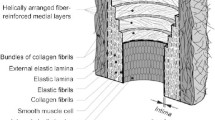Abstract
We present a method for predicting the wall stress in a class of cerebral aneurysms. The method hinges on an inverse formulation of the elastostatic equilibrium problem; it takes as the input a deformed configuration and the corresponding pressure, and predicts the wall stress in the given deformed state. For a membrane structure, the inverse formulation possesses a remarkable feature, that is, it can practically determine the wall tension without accurate knowledge of the wall elastic properties. In this paper, we present a finite element formulation for the inverse membrane problem and perform material sensitivity studies on idealized lesions and an image-based cerebral aneurysm model.
Similar content being viewed by others
References
Doyle TC and Ericksen JL (1956). Nonlinear elasticity. Adv Appl Mech 4: 53–115
Elger DF, Blackketter DM, Budwig RS and Johansen KH (1996). The influence of shape on the stresses in model abdominal aortic aneurysms. J Biomech Eng Trans ASME 118: 326–332
Frankel T (1997). The geometry of physics. Cambridge University Press, Cambridge
Goldberg MA (1965). A linearized large deformation analysis for rotationally symmetric membranes. ASME J Appl Mech 32: 444–445
Govindjee S and Mihalic PA (1996). Computational methods for inverse finite elastostatics. Comput Methods Appl Mech Eng 136: 47–57
Govindjee S and Mihalic PA (1998). Computational methods for inverse deformations in quasi-incompressible finite elasticity. Int J Numer Methods Eng 43: 821–838
Green AE and Adkins JE (1970). Large elastic deformations, 2nd edn. Clarendon Press, Oxford
Gruttmann F and Taylor RL (1992). Theory and finite element formulation of rubberlike membrane shells using principal stretches. Inte J Numer Methods Eng 35: 1111–1126
Humphrey JD (2002). Cardiovascular solid mechanics. Springer, New York
Humphrey JD and Canham PB (2000). Structure, mechanical properties and mechanics of intracranial saccular aneurysms. J Elast 61: 49–81
Humphrey JD and Kyriacou SK (1996). The use of laplace’s equation in aneurysms mechanics. Neurol Res 18: 204–208
Hsu FPK, Schwab C, Rigamonti D and Humphrey JD (1994). Identification of response functions from axisymmetrical membrane inflation tests—implications for biomechanics. Int J Solids Struct 31: 3375–3386
Hsu FPK, Liu ACM, Downs J, Rigamonti D and Humphrey JD (1995). A triplane video-based experimental system for studying axisymmetrically inflated biomembranes. IEEE Trans Biomed Eng 42: 442–450
Koishi M and Govindjee S (2001). Inverse design methodology of a tire. Tire Sci Technol 29: 155–170
Kyriacou SK and Humphrey JD (1996). Influence of size, shape and properties on the mechanics of axisymmetric saccular aneurysms. J Biomech 29: 1015–1022
Kyriacou SK, Schwab C and Humphrey JD (1996). Finite element analysis of nonlinear orthotropic hyperelastic membrane. Comput Mech 18: 269–278
Kyriacou SK, Shah AD and Humphrey JD (1997). Inverse finite element characterization of nonlinear hyperelastic membranes. J Appl Mech-Trans ASME, 64: 257–262
Lu J, Zhou X and Raghavan ML (2007a). Inverse elastostatic stress analysis in pre-deformed biological structures: demonstration using abdominal aortic aneurysm. J Biomech 40: 693–696
Lu J, Zhou X and Raghavan ML (2007b). Computational method of inverse elastostatics for anisotropic hyperelastic solids. Int J Numer Methods Eng 69: 1239–1261
Ma B, Harbaugh RE and Raghavan ML (2004). Three-dimensional geometrical characterization of cerebral aneurysms. Ann Biomed Eng 32: 264–273
Ma B, Lu J, Harbaugh RE and Raghavan ML (2007). Nonlinear anisotropic stress analysis of anatomically realistic cerebral aneurysms. ASME J Biomed Eng 129: 88–99
Naghdi PM (1972). The theory of plates and shells. In: Truesdell, C (eds) Handbuch der Physik, vol VIa/2, pp 425–640. Springer, Berlin
Pipkin AC (1984). Integration of an equation in membrane theory. J Appl Math Phys (ZAMP) 19: 818–819
Rossettos JN (1966) Nonlinear membrane solutions for symmetrically loaded deep membranes of revolution. Technical Report NASA TN D-3297, NASA
Schievink WI (1997). Intracranial aneurysms. New Engl J Med 336: 28–40
Scott A, Ferguson GG and Roach MR (1972). Comparison of the elastic properties of human intracranial arteries and aneurysms. Can J Physiol Pharmacol 50: 328–332
Seshaiyer P and Humphrey JD (2003). A sub-domain inverse finite element characterization of hyperelastic membranes including soft tissues. J Biomech Eng-Trans ASME 125: 363–371
Seshaiyer P, Hsu FPK, Shah AD, Kyriacou SK and Humphrey JD (2001). Multiaxial mechanical behavior of human saccular aneurysms. Comput Methods Biomed Eng 4: 281–289
Shah AD, Harris JL, Kyriacou SK and Humphrey JD (1998). Further roles of geometry and properties in the mechanics of saccular aneurysms. Comput Methods Biomech Biomed Eng 1: 109–121
Simo JC, Fox DD and Rifai MS (1990). On a stress resultant geometrically exact shell-model. Part III: computational aspects of the nonlinear-theory. Comput Methods Appl Mech Eng 79: 21–70
Steiger HJ, Aaslid R, Keller S and Reulen HJ (1989). Strength, elasticity and viscoelastic properties of cerebral aneurysms. Heart Vessels 5: 41–46
Taylor RL (2003). FEAP user manual: v7.5. Technical report. Department of Civil and Environmental Engineering. University of California, Berkeley
Toth M, Nadasy GL, Nyary I, Kerenyi T, Orosz M, Molnarka G and Monos E (1998). Sterically inhomogenous viscoelastic behavior of human saccular cerebral aneurysms. J Vasc Res 35: 345–355
Author information
Authors and Affiliations
Corresponding author
Rights and permissions
About this article
Cite this article
Lu, J., Zhou, X. & Raghavan, M.L. Inverse method of stress analysis for cerebral aneurysms. Biomech Model Mechanobiol 7, 477–486 (2008). https://doi.org/10.1007/s10237-007-0110-1
Received:
Accepted:
Published:
Issue Date:
DOI: https://doi.org/10.1007/s10237-007-0110-1




